9 transitional living room ideas that nail this old-meets-new style
Discover the appeal of transitional living room ideas with these tips and tricks from interior designers


- 1. Reinstate original features
- 2. Clash color in transitional living rooms
- 3. Add interest with sweeping curves
- 4. Sort out the key elements first
- 5. Introduce texture in transitional living rooms
- 6. Embrace different species of timber
- 7. Focus on seating in transitional living rooms
- 8. Invest in future heirlooms
- 9. Embrace the architectural bones of transitional rooms
With new trends hitting the interiors spotlight all the time, it’s easy to see why transitional living room ideas are on the rise. Not only does this classic blend of old and new suit every style and size of property, but it’s also a timeless look you’ll never tire of.
So if you want to learn how to create a transitional style in your living room, read on for our expert-approved tricks of the trade that nail that balance between embracing current interior design trends, but also ensure the room still feels classic.
What Is A Transitional Living Room?
Interior designers agree that transitional living rooms are a harmonious mix of traditional and contemporary style. You could try out elements of English country decor alongside mid-century modernism. Or neutral Scandi-style furniture within a listed building backdrop.
Above all else, these easy-on-the-eye living rooms are elegant, comfortable, and classic. This makes it a go-to style mantra whether it’s a busy family household or an apartment for one.
'The transitional living room redefines timeless grace with a modern twist, ensuring both comfort and a contemporary aesthetic,' says New York based designer Kati Curtis. 'It’s a blend where the essence of sleek and modern minimalism meets the warmth of classic style.'
What is the difference between transitional and traditional style living rooms?
Although transitional living rooms may share certain traits with traditional ones, there are differences too. Traditional spaces are often warm, heavy and cocoon-like with an emphasis on symmetry and saturated color. Transitional living rooms can include all of those elements too. However, the key difference for transitional style is blending the traditional with contemporary elements such as modern lighting or geometric patterns. The result is classic and timeless but with a fresh outlook.
9 Transitional Living Room Ideas
One of the big advantages of transitional living rooms is that they are timeless yet original. In your own home, this means decorating this important communal space with a balance of styles that you adore.
Design expertise in your inbox – from inspiring decorating ideas and beautiful celebrity homes to practical gardening advice and shopping round-ups.
For the living room, that could be an antique rug with a 1960s sideboard and modern art on the walls. Or perhaps a traditional couch upholstered in a contemporary striped fabric with a mix of patterned cushions.
'Transitional design is all about breaking free from the constraints of sticking solely to neutrals or adhering strictly to one aesthetic,' says British interior designer Matthew Williamson. 'For me, this means celebrating the unexpected juxtapositions, the harmonious clash of old and new, bold patterns alongside classic designs.'
There’s another big plus point for transitional living rooms too. With such a classic look, you can dip your toe in a few living room trends further down the line if you fancy a mini style update.
While this ‘anything goes’ style ethos sounds easy to pull off, it’s a good idea to follow a few design pointers. Read on for interior design style rules for transitional living rooms and get the perfect blend of old and new.
1. Reinstate original features
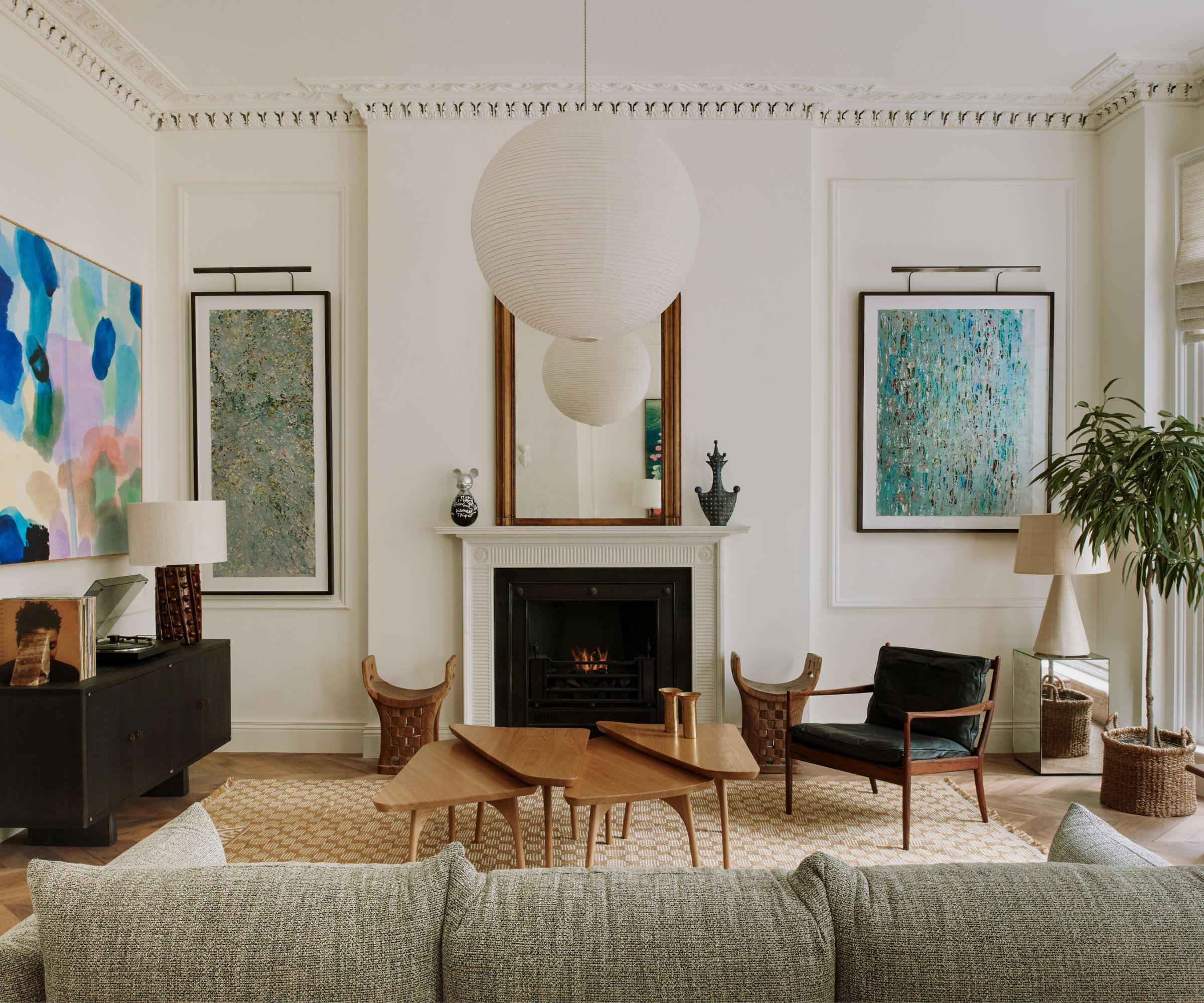
An effortless blend of vintage decor and contemporary is a hallmark of transitional living room style. And that includes the architectural detail of a room.
In period properties, restoring original details is a great starting point for your project. Look at reinstating fireplaces or plasterwork to suit the age of the house, whether these are originals or newer versions.
'For the living room in this Grade II listed townhouse, we restored the stunning cornice as well as introducing new Georgian moldings to frame the walls,' explains interior design Clémence Pirajean of London-based studio Pirajean Lees.
'We reinstated the Georgian fireplace, a central focal point of the living room that had been removed during a previous renovation. The marble hearth is a more contemporary detail, grounding the fireplace in our current era. We then layered these architectural details with a mix of antique and contemporary furniture and accessories.'
2. Clash color in transitional living rooms
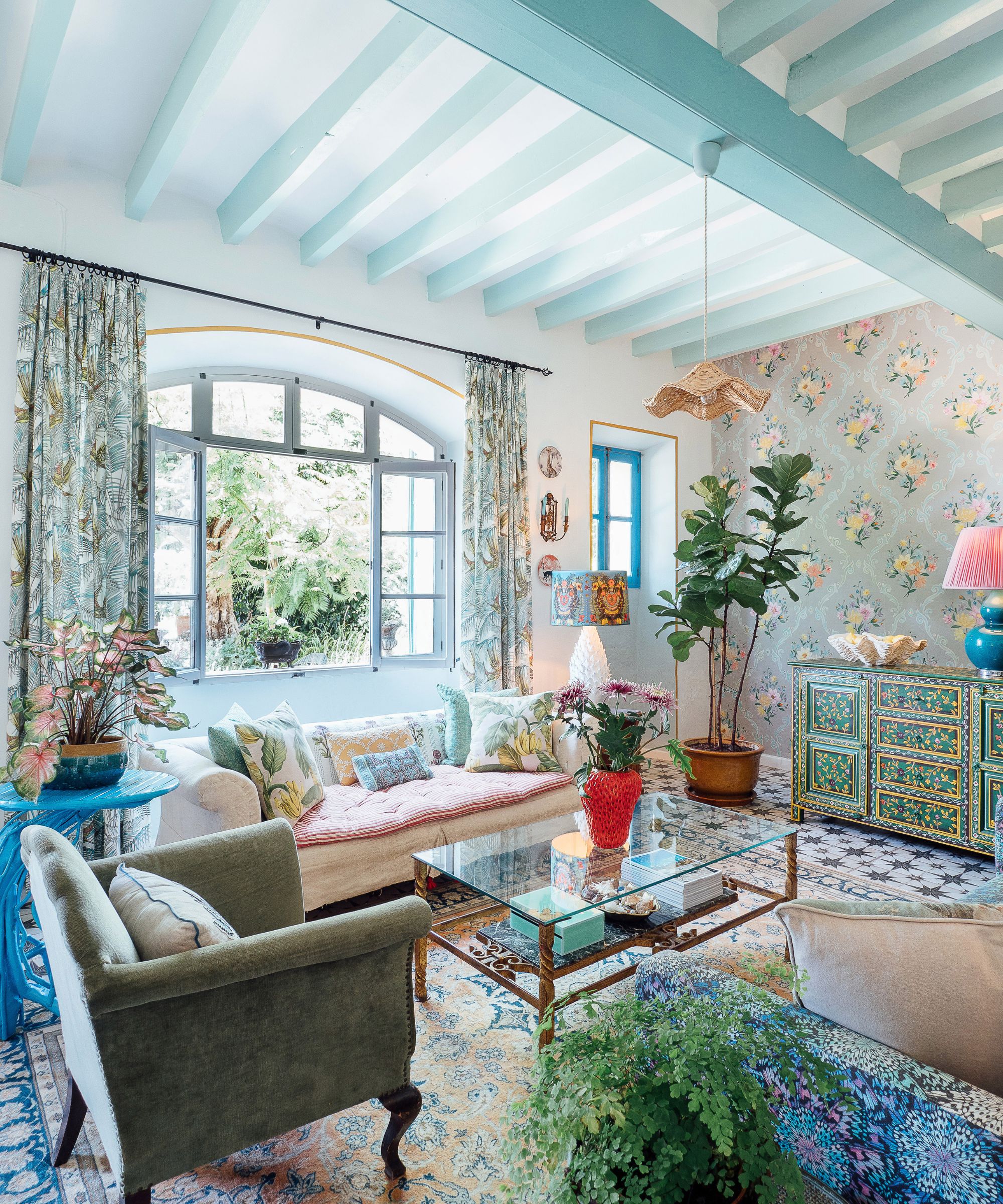
Just like transitional bedrooms, a mix of period and modern decor will create a unique and timeless living space you’ll never get tired of. For British interior designer Matthew Williamson, a playful use of color is one of the most important elements of this considered mash up of old and new.
'It’s about injecting personality and individuality into a space, and that, for me, means color,' he says. 'Color is the most powerful, exciting and universal tool in interiors. It’s the simplest way to make your home immediately joyful and optimistic and can work with a large variety of styles and aesthetics.'
This colorful living room is uplifted by bold pops of color, such as the soft aqua beams, cobalt blue side table, red strawberry vase, and hand-painted sideboard.
3. Add interest with sweeping curves

When designing a transitional living room, it’s important to soften any space that appears overly modern. This is especially so in a new-build home or extension which might have a boxy silhouette.
In this 1920s Tudor revival home, designed by Kentucky-based interior designer, Bethany Adams, the living room is located within a 1980s extension. With faux beams and a contemporary, plaster-finish fireplace, the new living room is indeed sleek and modern. However, the curvaceous ochre couch injects flow and a timeless family-friendly appeal.
'The idea was to have a highly climbable sofa, that would be comfortable for the whole family to curl up on to watch movies or read the newspaper while their young daughter played,' says Bethany. 'Crittall glass doors are modern but were also popular in 1920s homes so they leave one guessing.'
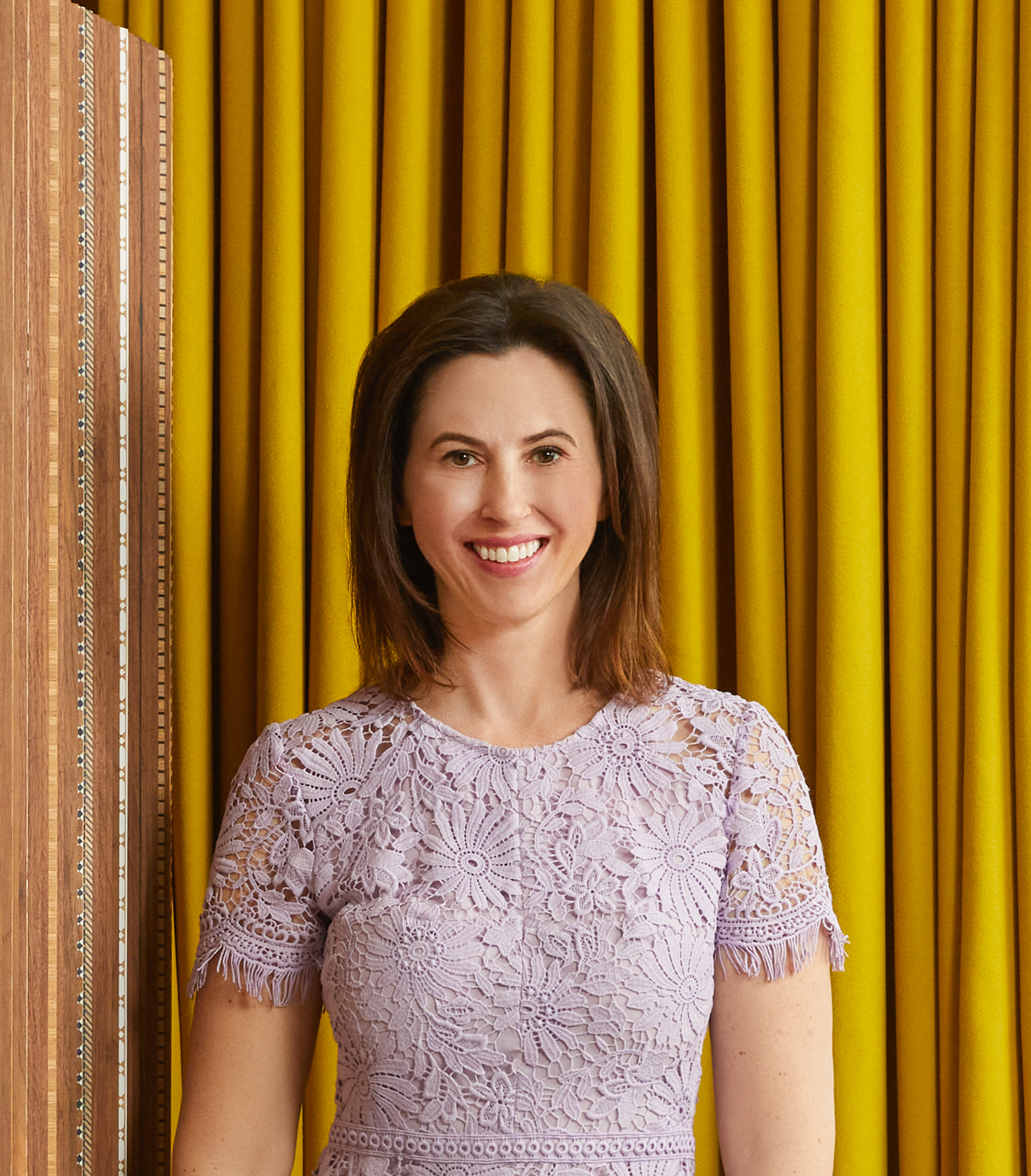
Based in Louisville, Kentucky, Bethany Adams has over 15 years of experience designing and project-managing high-end residential projects. She is a member of ASID (American Society of Interior Designers), AIA (American Institute of Architects) and a certified interior designer with the Kentucky Board of Architecture.
4. Sort out the key elements first

Layering color and decorating with pattern is a wonderful way to introduce a classic, transitional mood in your living room. But if you’re not confident with mixing up chevrons, stripes, and florals, the experts advise getting the big items sorted first.
Before you rush headlong into buying up piles of gorgeous print cushions, work out what you want for the main elements of the room.
'We always recommend looking at the key elements together such as paint and wallpaper and fabrics for key pieces like sofas and window treatments,' says London-based interior designer Kate Guinness. 'Once you have those things sorted, you can have fun playing around with what works for the smaller details, such as occasional chairs and cushions.'
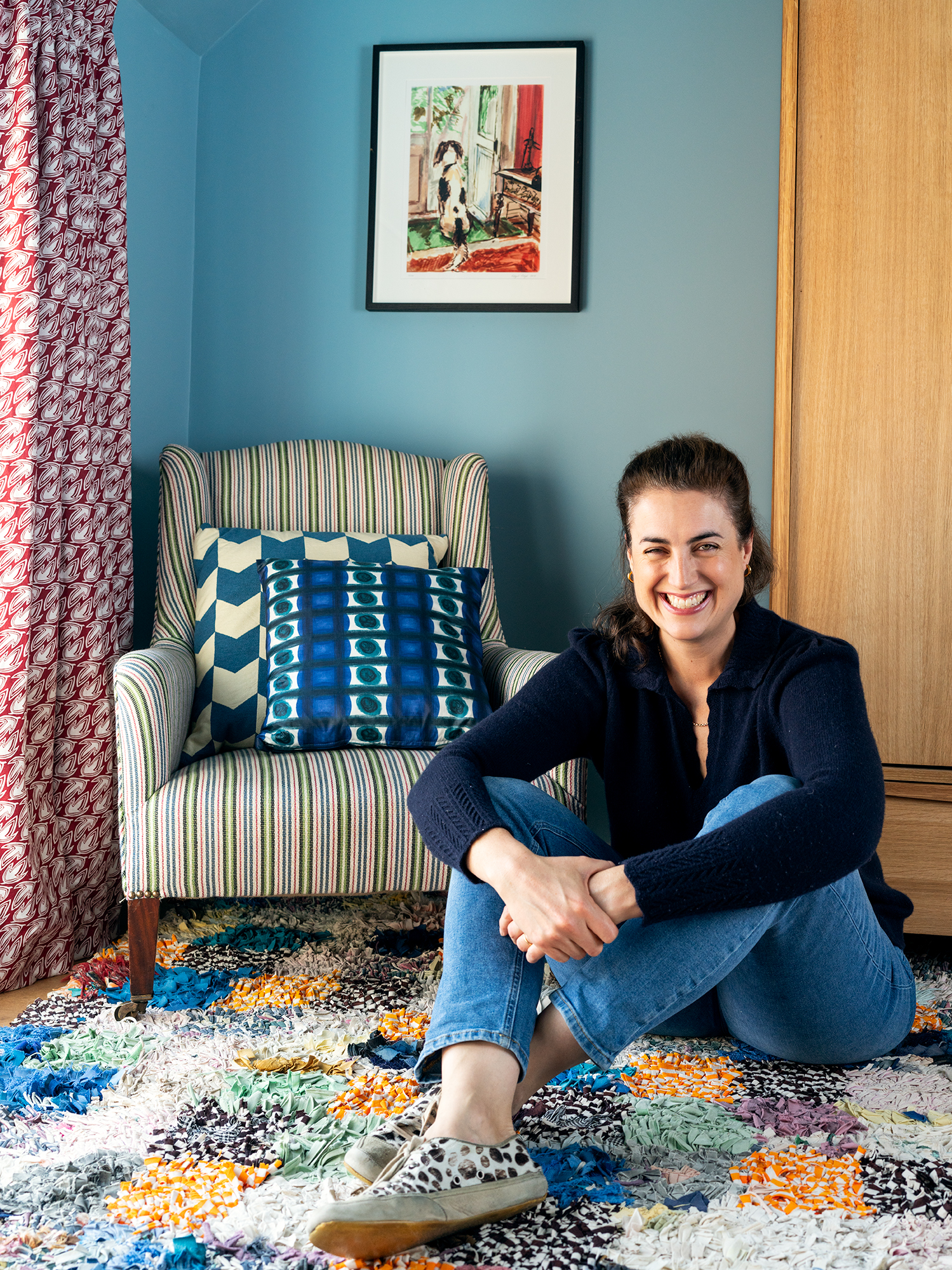
Kate Guinness Design is an interior design and decoration studio based between its West London studio and Wiltshire, working on both residential and commercial projects. They specialise in creating interiors with an authentic sense of accumulation, combining antiques, fabrics, color and art.
5. Introduce texture in transitional living rooms
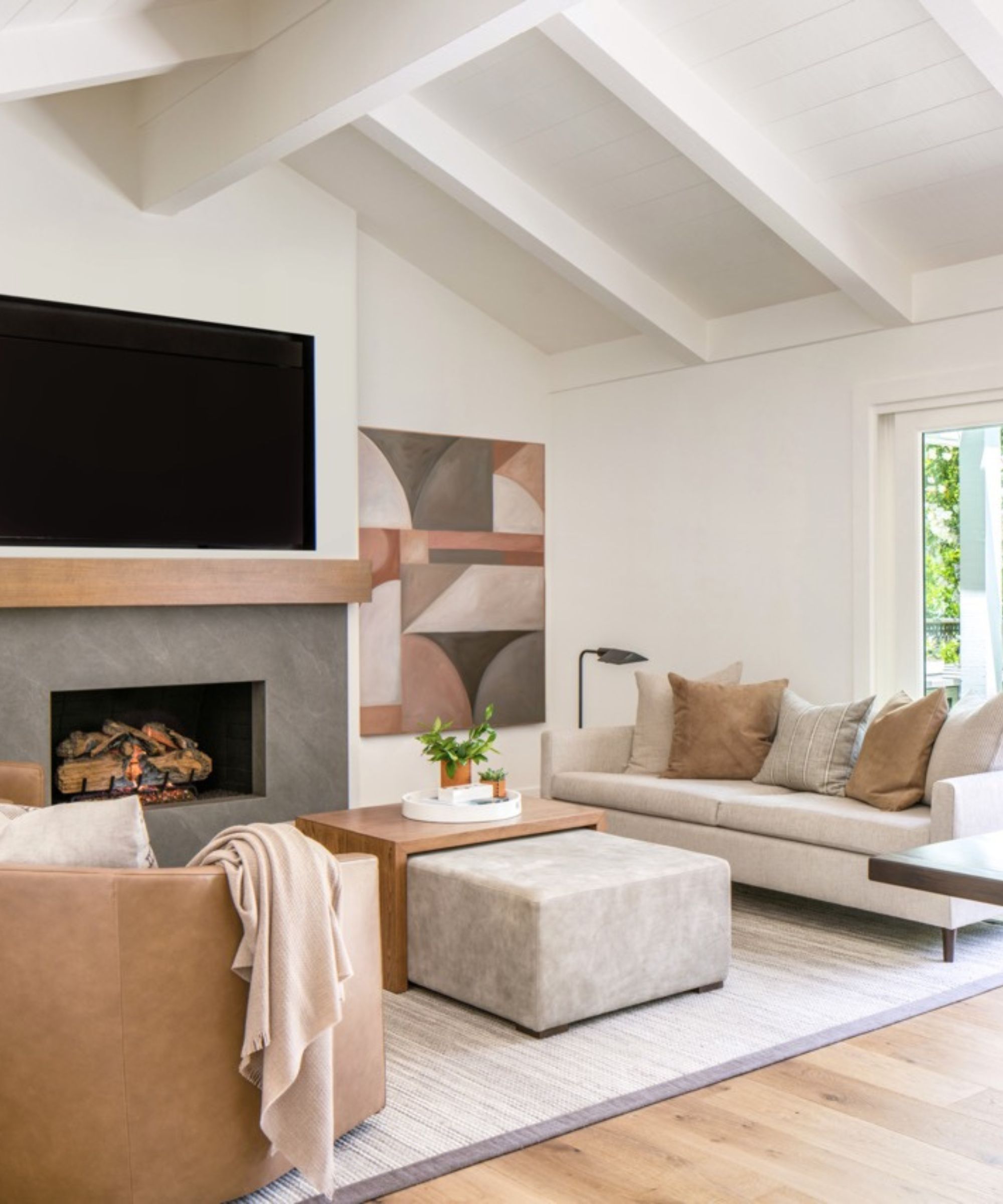
If you’re not a big fan of bold color or striking print, what’s the best way to add personality to a classic transitional living room?
A top tip is to introduce feel-good fabrics, especially in neutral living rooms. Not only will tactile elements cozy up a space, but textures such as wool, linen, and suede will add depth to a neutral color scheme.
'By anchoring the space in a neutral palette and embracing a variety of textures like leather and suede, this room skilfully mixes modern pieces with classic touches,' explains California-based designer Kriste Michelini. 'Homeowners should blend streamlined and heritage furnishings such as a sleek sofa set against a traditional fireplace and rug.'
6. Embrace different species of timber
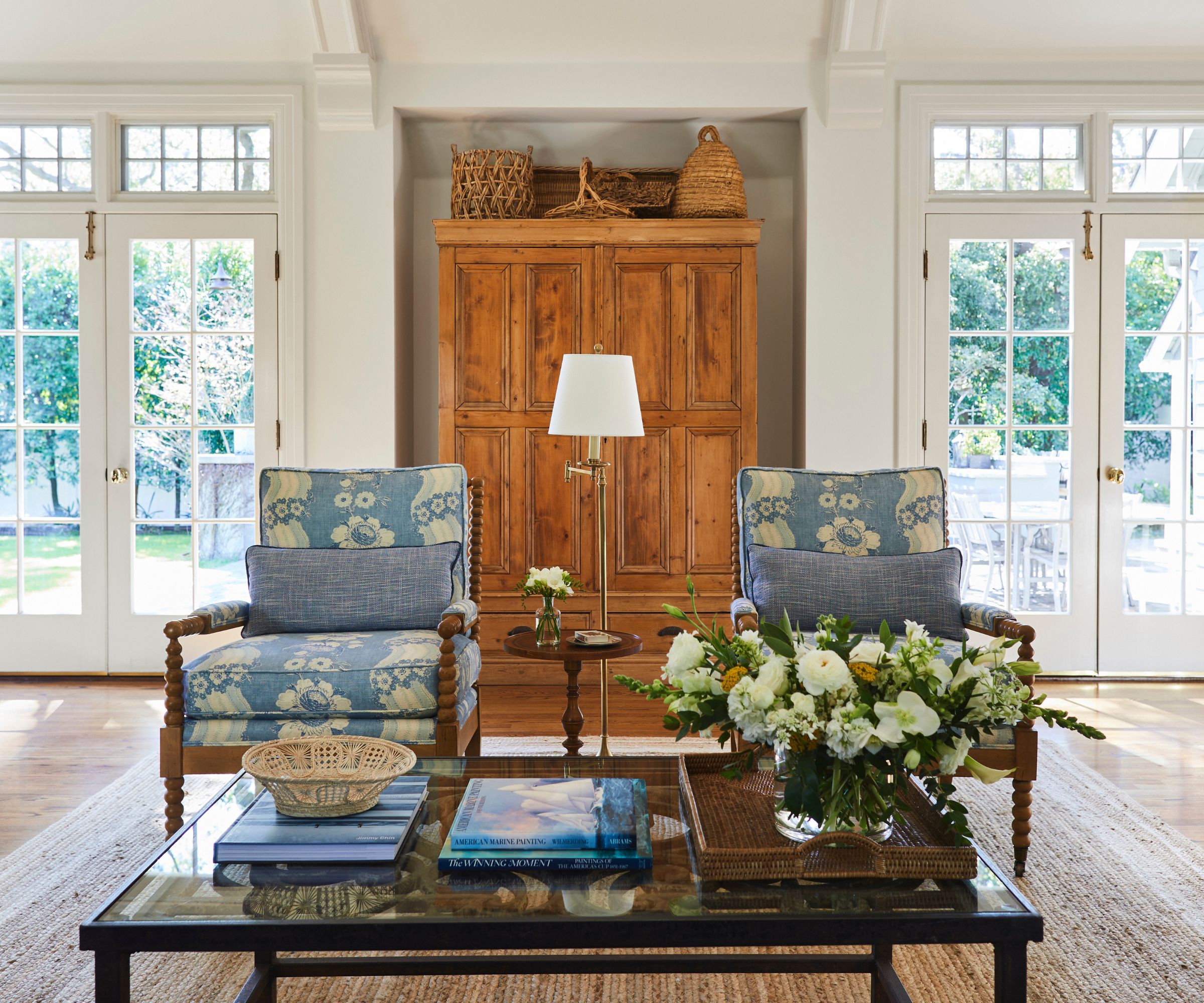
Wood furniture and timber floors work equally well in both modern and traditional decor. So what’s the best way to use the classic warmth and elegance of timber in transitional living rooms?
'Mixing and matching wood species and stains brings a lived-in feel,' explains interior designer Hayley English who is based in California. 'Here the rustic timber armoire and classic oak flooring is offset with white painted beams, woodwork and door frames for a contemporary backdrop that makes the space feel larger and fresh.'

Hayley English Interiors specializes in single family homes and appreciates traditional, yet approachable interiors for everyday living. Hayley is known for creating charming spaces through bespoke drapery, upholstery, and furniture, as well as sourcing one-of-a-kind pieces that tie together a home.
7. Focus on seating in transitional living rooms
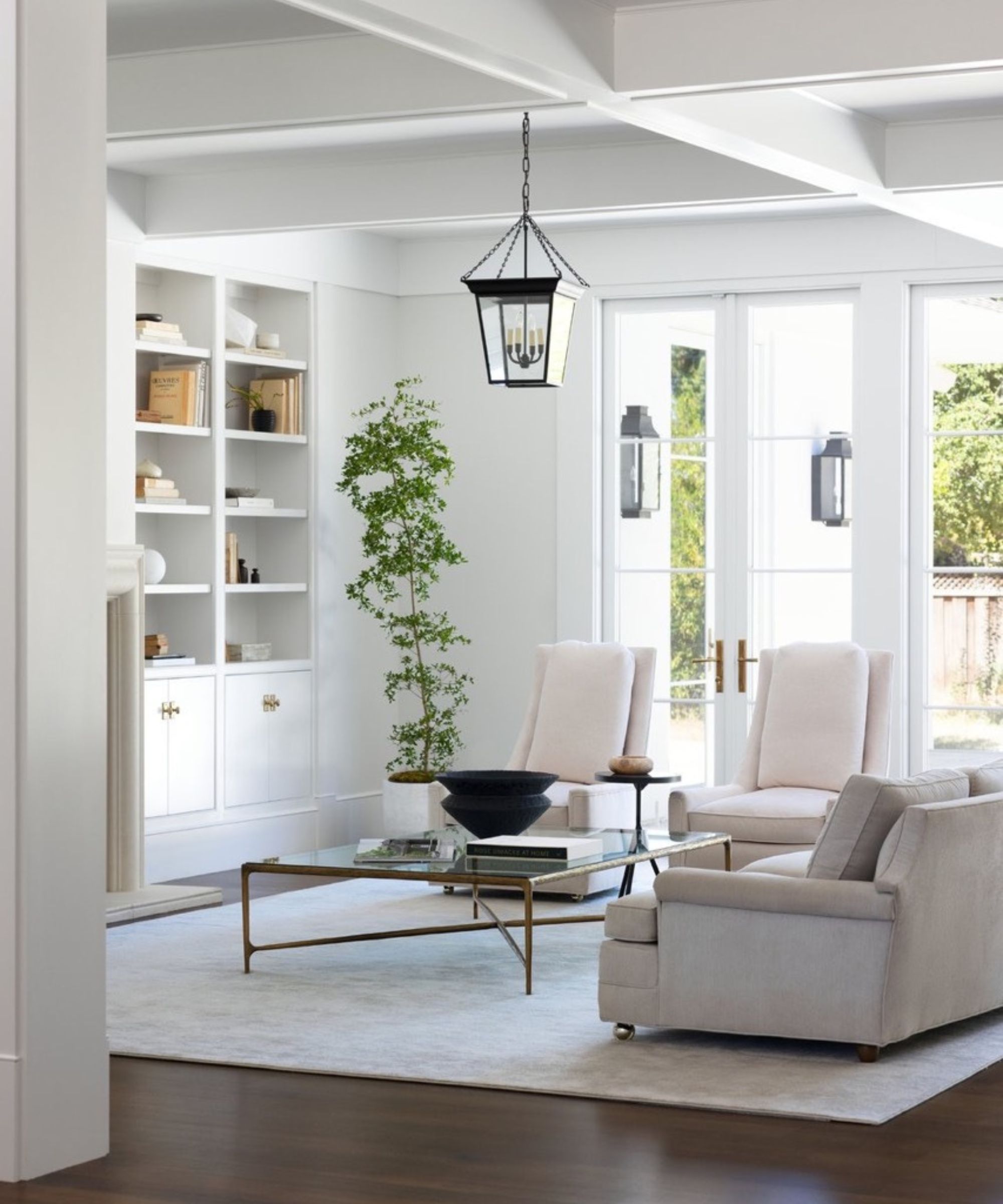
Transitional living rooms need to be comfortable as well as stylish. So, your choice of couch and chairs is one of the most significant elements of the space.
'In this transitional living space, we deliberately chose a 10ft sofa and two armless lounge chairs dating back to the 1960s, prized for their distinctive character, unique lines, and proportions,' enthuses Nikki Haramoglis, principal designer at San Francisco-based Westward Atelier. 'These pieces underwent a revitalization process, being skilfully upholstered in durable krypton fabric to withstand high traffic.'
The choice of earth-toned fabric contributes to the timeless aesthetic and harmonizes with the room’s sleeker, more contemporary elements such as the marble and forged iron tables.
8. Invest in future heirlooms

'For transitional living rooms, it is important to invest in what we like to call our ‘Future Heirlooms’,' explains Chloe Vince, in-house decorating consultant at House of Hackney. 'These are artistically designed pieces made by British craftspeople specializing in generations-old trades. They are beautiful, functional and last a lifetime.'
In typical House of Hackney style, the brand gives traditional furnishings a modern twist, spot on for a transitional design ethos. The Artemis Blush rug is woven by British heritage brand Axminster Carpets while the handcrafted Wilton sofa is covered in its own Wild Card leopard print jacquard.
9. Embrace the architectural bones of transitional rooms
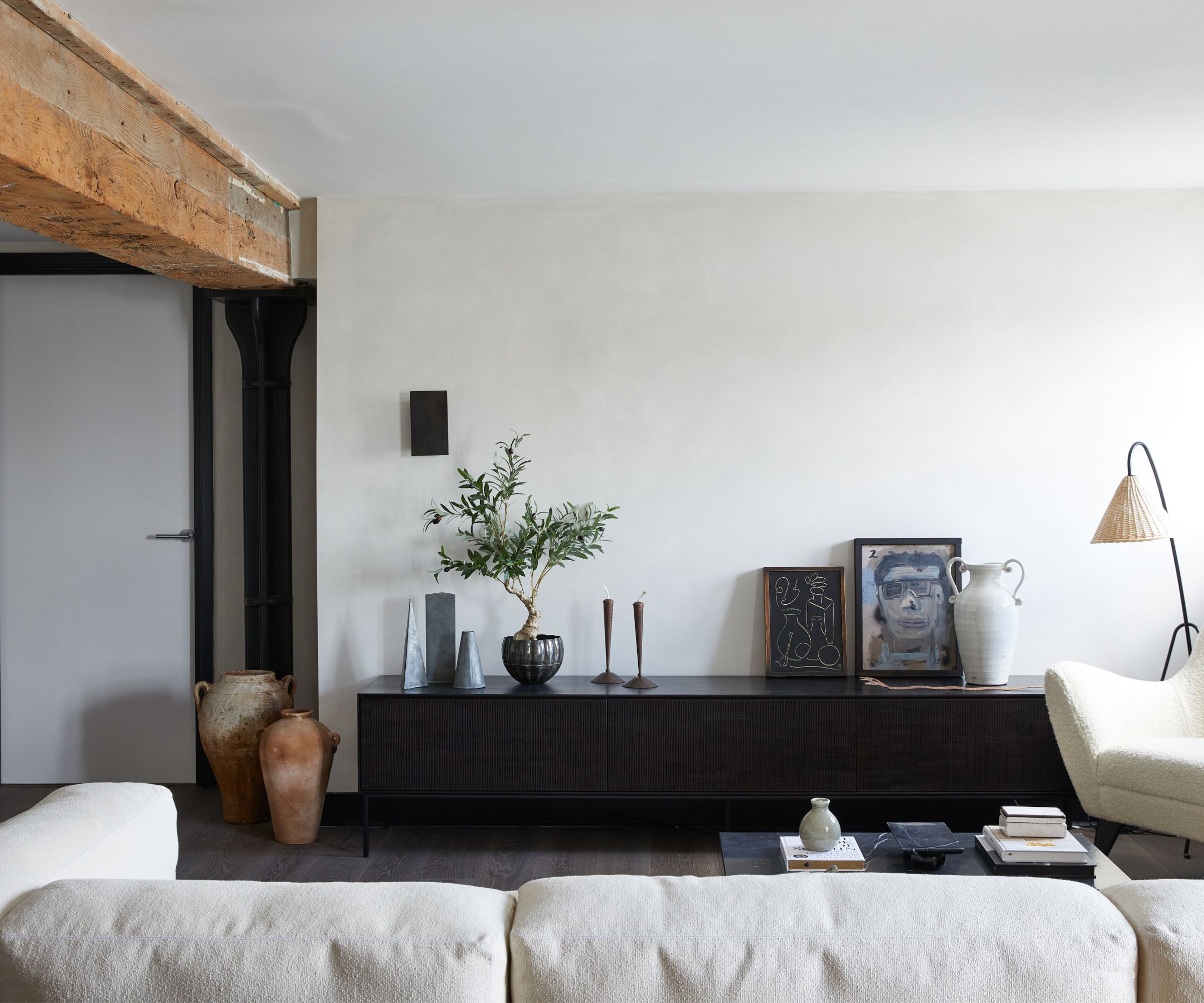
Respecting the architectural bones of a property is a crucial design tip, especially for transitional living rooms. Annie Harrison, founder of London-based design studio FARE INC. designed a worldly, cottage style in this Grade II-listed warehouse conversion (c. 1843), nestled along the River Thames in London.
;The apartment is dressed with light touch cultural patterns and modernist antiques,' says Annie, 'and the interior pays homage to its historic roots while embracing contemporary aesthetics. The original beams and columns, brimming with character, serve as the focal point, guiding the refurbishment process.'
The rustic charm is enhanced with tactile paints and rustic-grade flooring while monochromatic, Scandi-style decor and eclectic Eastern treasures add a touch of modernity.
Transitional living room ideas are always going to create timeless living rooms too. The blending of old and new, and different styles from different eras ensures a layered space, filled with depth and interest. Of course, you can bring into trends that you love too, but starting off with the transitional approach to your decor will result in a home that never dates.

Lara has worked in the ever-changing world of interiors and lifestyle journalism for many years. She cut her teeth in a busy newsroom of a kitchen and bathroom business title where she gained vast product knowledge and industry contacts that would prove invaluable. She now freelances for a variety of magazines, newspapers and online blogs and relishes the changing landscape of the interiors world.